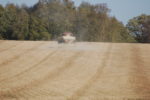Advertise Follow Us
Soil Health
Cracking The Code On No-Till Plant Diversity
Little is known about the organic compounds plants use for nutrient uptake and defense, but farmers can make these chemicals work for them by establishing a diverse no-till system.
Read More
What I've Learned from No-Tilling
Bucking The Tillage Trend In An Alpine Desert
No-till practices are saving Colorado grower Billy Burns’ soils, and even helping his fields recover from a tragic herbicide mistake.
Read More
Finding Your ‘ROI’ With Cover Crops In No-Till Systems
Cover-crop expert Dave Robison is working to generate some hard numbers to quantify the much-touted benefits of individual covers and cover-crop mixes on no-till operations.
Read More
‘Spray And Wait’ Is Critical To Tackling Green Bridge Pathogens
While green bridge is a major disease worry in the Pacific Northwest, it’s a problem Midwestern no-tillers should be leery of with certain crop rotations and cover crops.
Read More

.png?height=125&t=1731942302&width=150)










